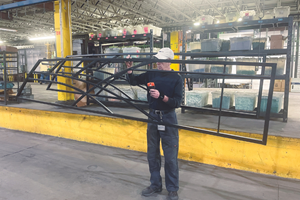Bubbles During Curing on Galvanized Steel
Question: We read with interest your April column in which you addressed problems with powder coating over galvanized steel.
Question:
We read with interest your April column in which you addressed problems with powder coating over galvanized steel. We have been electrostatic spray coating nylon on the tab of a hood latch for an automotive application. The latch is riveted onto the full latch assembly, and then the entire assembly is electrocoated. Originally the base metal was hot-rolled steel. After we had been running for 6 months, our customer changed to galvanized steel. Since that change, bubbles have been occurring intermittently during the curing part of the electrocoat process. Sometimes those bubbles burst and the underlying material is silver—indicating that the problem has occurred after the liquid bath. It has been our contention that the bubbles are caused by degassing from the galvanized coating during the cure phase of the electrocoat operation. Our customer has tried to link it to our process, but we point to several facts:
1. The bubbling never occurs in our nylon coating process.
2. The bubbling never occurred at all with the hot-rolled steel.
3. At our recommendation, our customer pre-heated the galvanized parts before they sent them to us. The bubbling rate was reduced from 30% to 10% (even though the temperatures were not as high as we would have recommended).
We believe that those facts point away from our process and to the galvanized metal as the cause. Our customer talked to a Ph.D. with many years of experience in failure analysis and corrosion. He said that there were two kinds of galvanized processes: hot-dipped and electrical. He indicated that hot-dipped galvanized (which is the process for this base material) does not produce hydrogen gas and, thus, could not have a degassing problem.
In order to confirm whether that statement was true, I looked up a large galvanizer in Thomas Register and spoke to a chemist there. He was quite puzzled but said that he did not understand why the particular process of galvanizing would be critical, since the hydrogen gas came from the zinc coating, which was present in each process. He wondered whether the combination of the zinc and the steel racks made a mild battery—the electrical charge from that would release hydrogen gas from the zinc coating. But then we didn't know why the bubbling under the nylon coating wouldn't have happened while in the liquid electrocoat stage. Perhaps the hydrogen gas is released through the electrocoat of the non-nylon coated area of the latch and is building on a microscopic scale in the pores of the galvanized metal under the nylon coating. As the parts come out of the electrocoat bath and into the oven the heat drives the hydrogen gas from the pores, and as it builds up under the nylon coating it causes a bubble, which may or may not burst.
Variation in the expression of this condition could be due to differences in the oven temperature, the position of the rack, the position of the part on the rack, the porosity of the part, etc. Can you give me any help on this? G.C.
Answer:
I normally don't contradict a Ph.D., especially since I'm only a B.S., but entrapped gas is most prevalent in hot-dipped galvanized products. It is commonly known that this gas will become released in the presence of heat, which is why most people preheat their parts to drive out the gas prior to coating them. So what you are seeing is the entrapped gas piercing the electrocoat during the cure process causing holes in the coating. Since the electrocoat is a thermoset type coating, the holes remain present. However, in the nylon-coated area, these same holes will flow closed and leave a smooth surface, since nylon is a thermoplastic type coating. Either that, or the nylon coating is applied so thick, that the entrapped gas cannot pierce the surface of the coating. Either way, I think this explanation suits the facts the best.
Your solution lies in preheating the parts prior to electrocoating them, using plated parts instead of hot-dipped parts or lowering your electrocoat cure oven temperature and increasing dwell time to more gently cure your parts.
Choose the method that will best satisfy your customer.
Related Content
Powder Coating Overcomes Post Forming
Six Sigma methodology, open communication, and collaboration produce results for leading boat manufacturer.
Read MoreOven System Wins Pace Award
The EcoInCure is designed to cure complex car bodies with superior paint quality faster and more efficiently than conventional ovens.
Read More5 Maintenance Tips for Gas Catalytic IR Ovens
Basic and periodic preventive maintenance is essential for avoiding oven downtime.
Read MoreCatalytic Gel Ovens Offer Small Operational Footprint
WolfRayet catalytic gel ovens offer small operational footprints while also providing a way to improve on existing convection curing.
Read MoreRead Next
Delivering Increased Benefits to Greenhouse Films
Baystar's Borstar technology is helping customers deliver better, more reliable production methods to greenhouse agriculture.
Read MoreA ‘Clean’ Agenda Offers Unique Presentations in Chicago
The 2024 Parts Cleaning Conference, co-located with the International Manufacturing Technology Show, includes presentations by several speakers who are new to the conference and topics that have not been covered in past editions of this event.
Read MoreEpisode 45: An Interview with Chandler Mancuso, MacDermid Envio Solutions
Chandler Mancuso, technical director with MacDermid Envio discusses updating your wastewater treatment system and implementing materials recycling solutions to increase efficiencies, control costs and reduce environmental impact.
Read More





















